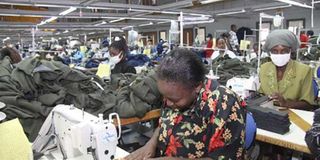Kenya living within its means - World Bank

A textile worker in Altex EPZ Textile Manufacturing for foreign markets at Athi River. PHOTO | FILE
What you need to know:
- The World Bank lists a decline in agriculture’s share of GDP declined from 26.5 per cent in 2006 to 22 per cent in 2014 while manufacturing stagnated at 11.8 per cent of GDP on average during the same period.
- The report says that domestic economic shocks have had bigger and longer-lasting effects than external shocks.
More than half of the increase in Kenya’s exports over the past ten years are attributable to the service sector according to a new World Bank report.
The report also pours praise on Kenya for its “embrace” of the private sector and for “living within its means.”
The report – the Kenya Country Economic Memorandum: From Economic Growth to Jobs and Shared Prosperity – looks both at the present economic model Kenya has and projects how this will perform in the future.
It says that since 2005, services exports in Kenya have accounted for over 50 per cent of the increase in total exports, and are poised to overtake goods exports, with trade, transport, ICT and financial services leading the pack.
“Kenya’s growth model has been well-regarded for a number of reasons. Unlike most of its African peers, the country embraced the role of the private sector from the start,” the report says.
“One major accomplishment and often under-appreciated aspect of the country’s growth story is that Kenya has lived within its means. The country has never sought or received debt relief, but has opted for better economic policy - raising revenues, liberalizing trade and the forex market.”
However, it is not all good news. The report warns that “there are distinct features of Kenya’s growth model that upset its growth story.”
The World Bank lists a decline in agriculture’s share of GDP declined from 26.5 per cent in 2006 to 22 per cent in 2014 while manufacturing stagnated at 11.8 per cent of GDP on average during the same period.
REVIVING AGRICULTURE
Of equal importance is the fact that “growth has not been inclusive,” with poverty, unemployment, and informality remaining prevalent.
“Reviving agriculture remains Kenya’s main pathway to poverty reduction. On jobs, improving the business environment, the education system, and reforming dated labour laws will help,” says Diarietou Gaye, World Bank Country Director for Kenya.
“On informality, the real gains come from increasing productivity in the Jua Kali sector”
The third concern is that economic growth has been “uneven and volatility is high.”
The report says that domestic economic shocks have had bigger and longer-lasting effects than external shocks.
In the future savings rates must be increased the report says. “To accelerate short-term growth, the current savings rate needs to be doubled, primarily by mobilizing domestic savings,” says Apurva Sanghi, World Bank Lead Economist and Program Leader for Kenya.
The report also identifies three long-term growth drivers: Innovation, Oil, and Urbanization. But, underpinning these recommendations is one overarching theme; that of functioning institutions that support development.
The Country Economic Memorandum is a strategic World Bank product that analyses key aspects of the country’s economic development with the main aim of providing an integrated and long term perspective of the country’s development priorities.





